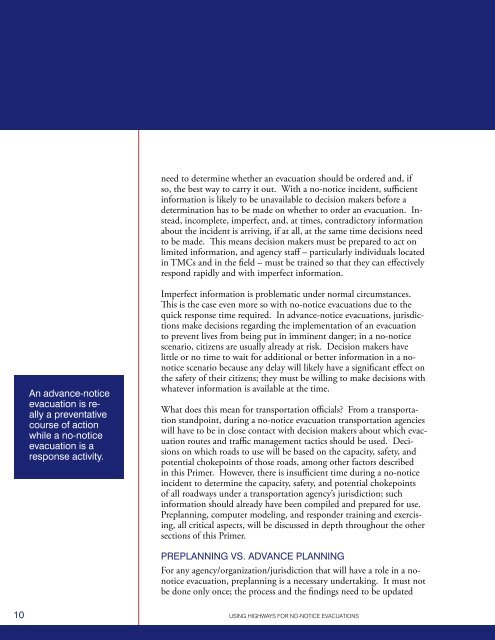using highways for no-notice evacuations - FHWA Operations - U.S. ...
using highways for no-notice evacuations - FHWA Operations - U.S. ...
using highways for no-notice evacuations - FHWA Operations - U.S. ...
Create successful ePaper yourself
Turn your PDF publications into a flip-book with our unique Google optimized e-Paper software.
need to determine whether an evacuation should be ordered and, ifso, the best way to carry it out. With a <strong>no</strong>-<strong>no</strong>tice incident, sufficientin<strong>for</strong>mation is likely to be unavailable to decision makers be<strong>for</strong>e adetermination has to be made on whether to order an evacuation. Instead,incomplete, imperfect, and, at times, contradictory in<strong>for</strong>mationabout the incident is arriving, if at all, at the same time decisions needto be made. This means decision makers must be prepared to act onlimited in<strong>for</strong>mation, and agency staff – particularly individuals locatedin TMCs and in the field – must be trained so that they can effectivelyrespond rapidly and with imperfect in<strong>for</strong>mation.An advance-<strong>no</strong>ticeevacuation is reallya preventativecourse of actionwhile a <strong>no</strong>-<strong>no</strong>ticeevacuation is aresponse activity.Imperfect in<strong>for</strong>mation is problematic under <strong>no</strong>rmal circumstances.This is the case even more so with <strong>no</strong>-<strong>no</strong>tice <strong>evacuations</strong> due to thequick response time required. In advance-<strong>no</strong>tice <strong>evacuations</strong>, jurisdictionsmake decisions regarding the implementation of an evacuationto prevent lives from being put in imminent danger; in a <strong>no</strong>-<strong>no</strong>ticescenario, citizens are usually already at risk. Decision makers havelittle or <strong>no</strong> time to wait <strong>for</strong> additional or better in<strong>for</strong>mation in a <strong>no</strong><strong>no</strong>ticescenario because any delay will likely have a significant effect onthe safety of their citizens; they must be willing to make decisions withwhatever in<strong>for</strong>mation is available at the time.What does this mean <strong>for</strong> transportation officials? From a transportationstandpoint, during a <strong>no</strong>-<strong>no</strong>tice evacuation transportation agencieswill have to be in close contact with decision makers about which evacuationroutes and traffic management tactics should be used. Decisionson which roads to use will be based on the capacity, safety, andpotential chokepoints of those roads, among other factors describedin this Primer. However, there is insufficient time during a <strong>no</strong>-<strong>no</strong>ticeincident to determine the capacity, safety, and potential chokepointsof all roadways under a transportation agency’s jurisdiction; suchin<strong>for</strong>mation should already have been compiled and prepared <strong>for</strong> use.Preplanning, computer modeling, and responder training and exercising,all critical aspects, will be discussed in depth throughout the othersections of this Primer.PREPLANNING VS. ADVANCE PLANNINGFor any agency/organization/jurisdiction that will have a role in a <strong>no</strong><strong>no</strong>ticeevacuation, preplanning is a necessary undertaking. It must <strong>no</strong>tbe done only once; the process and the findings need to be updated10 USING HIGHWAYS FOR NO-NOTICE EVACUATIONS
















